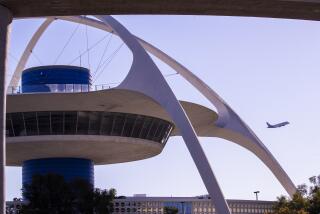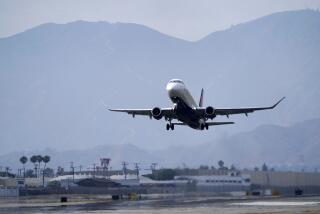Averting Midairs : Controllers’ Training to Be Bolstered
- Share via
Air traffic controllers in California, Arizona, Nevada and Hawaii will undergo special “reinforcement” training to help them spot and issue warnings about aircraft that may be heading for a midair collision, Federal Aviation Administration officials said Wednesday.
The announcement comes about six months after the collision of an Aeromexico jetliner and a small plane over Cerritos that claimed 82 lives.
While not conceding any direct cause-effect relationship between the Cerritos disaster and the announcement, Dick Morrison, a special projects officer for the FAA’s Western Pacific Region, said Wednesday that the need for such training “may have been brought to light” by the Aug. 31 collision.
FAA officials have said that in the crash and in an eerily similar near-miss involving an Aeromexico jet and a small plane on Jan. 31, controllers involved said they had not seen the image of the small plane on their display screens. But tape-recordings showed that radar antennas had picked up the small planes in both incidents.
Morrison said controllers will undergo expanded instruction on radar simulators during their regular biannual refresher courses. The instruction is designed to provide them with a better understanding of approved FAA procedures for maintaining separation between aircraft.
He said “it is anticipated that all radar controllers will vastly improve their ability to scan their radar presentations more efficiently, thus reducing the possibility for non-observance of displayed aircraft.”
Morrison said he could not speculate on what happened in either the midair collision over Cerritos or the near-miss. But he provided information that indicated that the failure to see the planes was probably due more to procedures followed by controllers than to some problem with the equipment.
Morrison told a news conference at the Terminal Radar Approach Control center at Los Angeles International Airport that three “problem areas” could cause controllers to miss planes picked up by their radar antennas: inadequate capacity of the computer that processes the incoming radar data, a malfunction of the radar gear and “human issues.”
Studies have ruled out the first two, Morrison said, leaving FAA experts to focus on the third--the procedures controllers are using to observe traffic on their screens.
The procedures include two potential sources of concern, Morrison said.
One involves controllers suppressing images on radar screens or reducing the brightness of the screens.
For example, during stormy weather, a controller may squelch “primary” radar targets on his screen to avoid the clutter of unwanted images from clouds. This also would eliminate simple radar “echoes” from the planes. But the “secondary” images of aircraft with on-board, broadcasting transponders would still show up on the screen.
All commercial airliners carry transponders, but small planes flying outside the restricted airspace around major airports are not required to have the devices.
The second concern involves what Morrison called “controller observance”--whether a controller may have overlooked a plane that actually appeared on a screen.
While conceding that “it certainly is possible for a controller not to observe a target,” Morrison stressed that controllers are “conscientious and dedicated professionals who place the safety and separation of aircraft under their control as their highest priority.”
He pointed out that controllers busy with aircraft under their guidance may not have time to issue advisories about other planes whose altitude is not shown on their screens--planes that, if they are obeying the rules, should be safely out of harm’s way.
More to Read
Sign up for Essential California
The most important California stories and recommendations in your inbox every morning.
You may occasionally receive promotional content from the Los Angeles Times.










